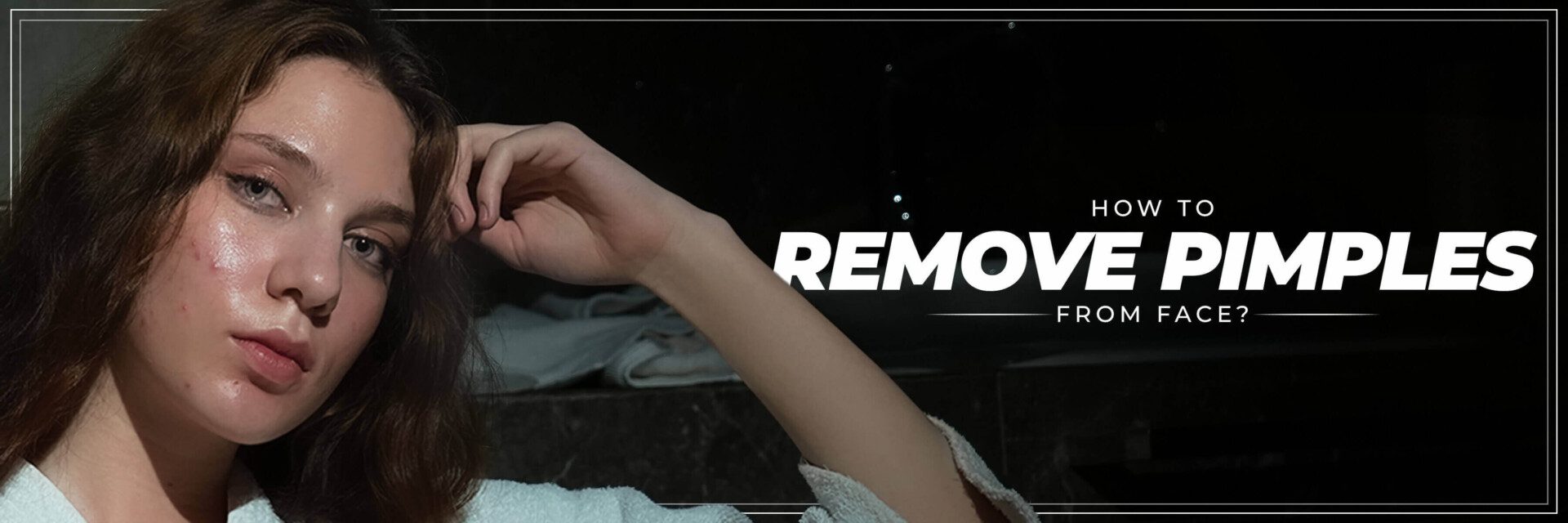
Pimples are the most common skin problem in the world., so it’s no surprise they always seem to show up at the worst times: like the day before a big job interview, right before an event you’ve been looking forward to, or just in time for a family photo. We’ve all been there! But pimples are more complicated than we used to think, and you don’t have to just wait for them to go away. Let’s explore how to get rid of pimples quickly.
Things to Keep in Mind
Don’t pop your pimples! I know it’s hard to resist, but squeezing them just makes them redder and hurt more. Plus, when you try to pinch or squeeze too hard, it can hurt the skin around the pimple and leave scars or dents that last. In a minute, we’ll talk about better ways to deal with pimples, but first, let’s understand what they are.
What are Pimples?
To treat pimples properly, we first need to understand what they are. Let’s break it down.
Pimples are little bumps that appear on your skin. They can get red or swollen. Acne usually causes pimples, and they mostly show up on your face, chest, shoulders, and upper back.
What Causes Pimples?
Pimples happen for a lot of reasons, and they’re usually triggered by changes in our hormones. Things like puberty, pregnancy, and menopause can make our bodies produce extra oil or get rid of too many skin cells. And let’s not forget about periods! When this happens, pimples start to form, and normal skin bacteria go into overdrive in the pores. All that extra bacteria irritates the skin and makes the pimples worse. So, you might be wondering: What Happens to Your Skin When You Get a Sunburn? It becomes red, painful, and may peel.
Now that we know what causes pimples and how they form, let’s check out the top 12 ways to get rid of pimples fast.
12 Ways to Get Rid of Pimples Fast
Wash Your Face Twice a Day
The American Academy of Dermatology suggests washing your face twice a day and after sweating. When use face wash, make sure to apply it on a wet face and rinse thoroughly. This helps keep your pores from getting clogged. Use a gentle cleanser and apply it with your fingertips, rubbing in small, circular motions. Afterward, rinse your face with warm water and pat it dry with a clean towel.
Put Ice on the Pimple
The first thing you should do to calm a painful pimple is put ice on it. Wrap some ice in a cloth and press it on the pimple for 3 to 4 minutes. If the ice melts fast, just put a few cubes in a plastic sandwich bag, then wrap it in the cloth. Do this a few times a day to help reduce the swelling and make your skin feel better. Learn How to Stop Drying Out Your Skin by using proper moisturizers and hydration methods.
Keep your hair clean
Too much oil in your hair can move to your skin and make acne worse. Washing your hair often can help prevent acne, especially near your hairline. Hair care products with oil can also cause pimples on your head and around the hairline. Try to avoid these products to lower the chance of getting pimples.
Avoid making your skin worse
Popping pimples can make them heal slower and leave scars. Scrubbing your skin too much can also make acne worse. Try not to touch your pimples, especially with dirty hands. This stops bacteria from your hands from getting on your face and causing more pimples. Here’s how to determine your skin’s undertone to choose the right products for your complexion.
Apply a Paste of Crushed Aspirin to the Pimple
Crush one or two aspirin tablets and mix them with a few drops of water to make a paste. Aspirin has salicylic acid, which helps get rid of extra oil and dead skin. Put the paste right on the pimple to reduce swelling, redness, and pain. Leave it on for 10 to 15 minutes, then wash it off well with warm water.
Wash your sheets and pillowcases often
Things like bacteria, dead skin, and dirt build up on stuff you touch a lot, like pillowcases, bedsheets, and clothes. This gunk can clog your pores and cause pimples. If you keep getting pimples in the same spot, washing anything that touches that area often can help stop breakouts. Try changing your bed sheets once a week and your pillowcases 2–3 times a week to keep your skin clear.
Use an Over-the-Counter Acne Spot Treatment
When picking an acne product from the store, focus on two key ingredients: salicylic acid and benzoyl peroxide. Salicylic acid helps get rid of dead skin, while benzoyl peroxide not only reduces oil but also kills the bacteria that cause pimples. Both are safe, but the product you choose and how often you use it depends on your skin type. French DNA plays a role in the natural beauty of French skincare routines.
Be careful though, both salicylic acid and benzoyl peroxide can dry out your skin. Using too much or combining them with other products can cause irritation. Stick to products with 0.5 to 2% salicylic acid. Also, limit your time in the sun when using benzoyl peroxide, including avoiding tanning beds. Use a paraben-free sunscreen to protect your skin from harmful UV rays. Start slow with any new product, and don’t use more than you need.
Use Makeup with Salicylic Acid to Hide Pimples
We can’t just stay home because of pimples. Thankfully, there are many makeup products that can help us cover up pimples while also fighting them. Just like acne spot treatments, there are a few important words to look for on products like foundation, face powder, and concealer labels.
Ingredients in Makeup for Acne: Makeup for acne-prone skin often has the same ingredients as over-the-counter treatments. One of the most common is salicylic acid. Foundations with salicylic acid cover pimples naturally while treating acne and stopping new breakouts.
Brands like Neutrogena, E.L.F., and Clinique make these kinds of products. Other helpful ingredients include sulfur, which reduces oil and unclogs pores, and hyaluronic acid, which keeps skin from drying out. But, like with any acne treatment, you need to think about your skin type. If your skin is dry, look for products that clear pores without drying it more.
What to Look for in Acne-Fighting Makeup: When choosing makeup to cover pimples or keep skin clear, always look for the word “noncomedogenic.” This means the product won’t clog your pores. Pimples are caused by clogged pores, so products that don’t cause this are better. You can also look for words like “hypoallergenic,” which is good for sensitive skin, and “clinically tested,” which means dermatologists have tested the product. There are many options, so you should find one that works for you.
Use a Face Mask for Acne
There are tons of face masks out there, and many of them help with pimples. Look for ingredients like salicylic acid and benzoyl peroxide. These work by unclogging pores and reducing redness. Sulfur is another ingredient that does the same thing. Even though sulfur might remind you of eggs or matchsticks, it helps with pimples, especially if your breakout isn’t too bad. It’s also gentler than salicylic acid and benzoyl peroxide, so it’s a good option if your skin is sensitive.
When picking a face mask for acne, look for words like “exfoliating” and “anti-inflammatory.” Depending on your skin type, you might also want a product that says it’s “calming,” “hydrating,” “soothing,” or good for “detoxing” your skin. Some masks have “antioxidant” or “antibacterial” benefits too. Different face masks have ingredients that balance out the drying effects of acne-fighting stuff and help your skin feel better. A lot of them use natural ingredients like tea tree oil or green tea, which are great for calming the skin and fighting inflammation.
Get a Cortisone Shot to Get Rid of a Pimple Fast
For big, painful pimples, store-bought creams might not work well enough. In that case, getting a cortisone shot directly into the pimple can help. A doctor uses a super thin needle to inject cortisone, which reduces the swelling and helps the pimple heal faster. You can get this done quickly, and you’ll see a difference within 24 hours.
We know how frustrating pimples can be. Luckily, these quick fixes can help for now. Just remember, having acne is totally normal, and it’s talked about a lot on social media through the acne positivity movement. You don’t have to feel bad about it, and you don’t have to deal with acne on your own.
Keep your face care products clean
To keep your skin clean, wash makeup, facial sponges, and brushes regularly with soap and water. This stops bacteria from building up, which can cause breakouts. Also, make sure brushes are fully dry before using them again. Here’s how to use skincare products properly for the best results.
Changing your diet and lifestyle
Acne and pimples happen more often in Western countries, with over 80% of people affected. This has led scientists to believe that what you eat and how you live might play a role in getting pimples.
A study in 2018 looked at 14 other studies and found that dairy might be linked to acne, especially for people aged 7 to 30. Dairy has amino acids that make your body produce more insulin, which can increase something called insulin-like growth factor-1 (IGF-1). Researchers think IGF-1 might be a big factor in causing acne.
But scientists need to make sure other things like age, gender, and genetics aren’t messing with the results. The Impact of Diet on Skin: Foods to Embrace and Avoid for a Healthy Complexion includes eating fruits and avoiding processed foods.
Other things in your diet and lifestyle might also affect acne. Some people say doing the following can help reduce pimples:
- Reducing stress
- Eating a balanced diet with lots of fruits, veggies, protein, and healthy fats
- Sleeping well and regularly
- Exercising regularly
Can toothpaste get rid of pimples?
A lot of people think toothpaste can help with acne, but that’s just a myth. A while ago, some toothpaste had an ingredient called triclosan, which studies said might reduce oil on the skin. But the FDA banned triclosan in products like toothpaste, which you wash off with water. Now, toothpaste doesn’t have ingredients that can help with acne.
The American Academy of Dermatology (AAD) says you shouldn’t use toothpaste on pimples. They also don’t recommend:
- Scrubbing: Scrubbing doesn’t get rid of acne. In fact, it can make things worse. Instead, wash your face gently.
- Tanning: Tanning doesn’t help acne. It actually harms your skin and increases the risk of skin cancer.
- Popping pimples: Popping pimples can make them look worse, cause irritation, and lead to scarring or infection.
FAQs
How do I clear a pimple on my face?
Scrub, exfoliate, apply heat, use natural masks or spot treatments, stick to a skincare routine, reduce stress, and eat healthy.
How can you get rid of pimples fast?
Use spot treatments like benzoyl peroxide, salicylic acid, or a paste of crushed aspirin and water.
How can I stop pimples on my face permanently?
Keep your face clean, use the right skincare, shampoo regularly, avoid touching your face, and stay out of the sun.
Can ice remove pimples?
Ice may reduce swelling, but it won’t fix the cause of acne. For serious acne, see a doctor.
Conclusion
Pimples are a common skin problem that usually show up on the face and upper body. They’re not dangerous, and many go away on their own in a few days or weeks. But sometimes, pimples stick around and need treatment to clear up. Keeping good hygiene, trying home remedies, and using over-the-counter products can help. If those don’t work, a dermatologist can create a plan to treat them. With the right treatment, you might start seeing better skin in a few months.

